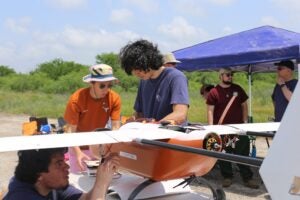AUSTIN, Texas—A 185,708-acre area of marshes, mangroves, open water and coastal prairie along the Texas Gulf coast will become a National Estuarine Research Reserve in a May 6 designation ceremony at The University of Texas at Austin Marine Science Institute (UTMSI) in Port Aransas, Texas.

|
|
The Mission-Aransas National Estuarine Research Reserve. Click photo above for high-resolution image of Mission-Aransas NERR.
|
Federal, state and local officials will welcome the Mission-Aransas National Estuarine Research Reserve (NERR) as the 27th member of the National Oceanic and Atmospheric Administration’s (NOAA) reserve system with a keynote address from Senator Kay Bailey Hutchison.
“Estuarine reserves are living laboratories,” said William Powers Jr., president of The University of Texas at Austin. “The University of Texas is proud to add its considerable expertise to the important work of the National Estuarine Research Reserve System.”
The new reserve, which will be managed by UTMSI in partnership with NOAA, is in Aransas and Refugio counties about 30 miles northeast of Corpus Christi on the Texas coast.
“As the first reserve in the western Gulf of Mexico, Mission-Aransas adds significant value to the National Estuarine Research Reserve System and broadens the opportunities to study, understand and manage America’s coastal ecosystems,” said retired Navy Vice Admiral Conrad C. Lautenbacher Jr., Ph.D., under secretary of commerce for oceans and atmosphere and NOAA administrator.
The reserve will attract scientists and students from across the nation to study at the site, including up to two national graduate research fellows funded annually by NOAA. NERR designation ensures access to federal funding for research and education programs, environmental monitoring and science-based training programs for coastal managers and decision-makers.

|
|
The Mission-Aransas National Estuarine Research Reserve. Click photo above for high-resolution image of Mission-Aransas NERR.
|
“The western Gulf of Mexico has a number of unique features, including coastal prairies, oak savannahs, and extensive seagrass and black mangrove communities that will help broaden the understanding of estuarine ecosystems nationwide,” said Paul Montagna, Mission-Aransas reserve manager and professor of marine science at UTMSI. “Research and monitoring here will help coastal decision makers manage these vital resources on a foundation of sound science, and it will help to educate the next generation of marine scientists and decision makers. This is good for Texas and good for the nation.”
Official designation of the Mission-Aransas NERR culminates a four-year process from site selection through the environmental impact study and the development of a comprehensive management plan. The Mission-Aransas site was proposed by Texas Governor Rick Perry in March 2004 after a two-year site selection process.
NOAA’s reserve system includes 27 estuarine locations in 21 states and Puerto Rico that are protected for research, education, outreach and stewardship. Mission-Aransas will be the third largest reserve in the system and includes the wetland, upland and marine environments typically found in the western Gulf of Mexico.
NOAA’s National Estuarine Research Reserve System is part of the National Ocean Service.
Editor’s note: Video footage and high-resolution images of the Mission-Aransas reserve are available for the media. To obtain a copy, please contact Lee Clippard at 512-232-0675 or lclippard@mail.utexas.edu. Photos: Sally Morehead-Applebaum and John Williams, Marine Science Institute.
For more information contact: Sally Morehead-Applebaum, UTMSI, 361-749-6771; Lee Clippard, UT Austin, 512-232-0675; George Cathcart, NOAA, 301-713-3155 ext. 141 or 301-538-9247 (cellular).



